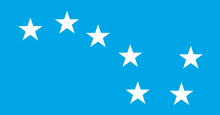Republican Congress
Republican Congress An Chomhdháil Phoblachtach | |
|---|---|
 Starry Plough of the Congress | |
| Founder | Peadar O'Donnell |
| Founded | 1934 |
| Dissolved | 1936 |
| Paramilitary wing |
Connolly Column (1936) |
| Ideology |
Irish republicanism, Marxism–Leninism |
| Political position | Far-left |
| Colours | Blue and white |
The Republican Congress (Irish: An Chomhdháil Phoblachtach) was an Irish republican and Marxist-Leninist political organisation founded in 1934, when pro-communist republicans left the Anti-Treaty Irish Republican Army. The Congress was led by such anti-Treaty veterans as Peadar O'Donnell, Frank Ryan and George Gilmore. In their later phase they were involved with the Communist International and International Brigades paramilitary; the Connolly Column.
The group claimed: "We believe that a republic of a united Ireland will never be achieved except through a struggle which uproots capitalism on its way."[1] They were not a political party as such, but rather an extraparliamentary organisation dedicated to creating a "workers' republic," which leaned towards the Communist Party of Ireland. They split mostly over whether they should be a party in their own right.
History
A group of republicans had founded a party, Saor Éire, in 1931, but it was banned later in the year. Despite this, many figures on the left wing of the Irish Republican Army (IRA) felt that the creation of a new party remained a priority, as they feared that supporters would otherwise turn to Fianna Fáil and the Communist Party of Ireland. The IRA organised a convention of its members in March 1934, which voted against creating a new party by a majority of one. The supporters of a new party, including Ryan, Michael Price, Gilmore, O'Donnell and Mick Fitzgerald, then walked out, and proceeded to create a new organisation.[2]
On 8 April 1934, the founding conference of the Republican Congress party was held in Athlone, and a head office was established on Pearse Street in Dublin. The IRA published a statement which described the new party as "an attack by Republicans [which] can only assist the campaign of the Capitalist and Imperialist elements", and stating that they expected the party would soon drop abstentionism towards the Dáil. The former IRA members in the party leadership were expelled from the paramilitary organisation, but some less prominent figures, including Sheila Humphries, Eithnie Coyle, Charles Reynolds, Seamus de Burca and George Leonard withdrew once they saw the IRA statement. However, other IRA members were won over and joined the Congress, including Liam Kelly, Joseph Doyle, Norah Connolly and Roddy Connolly.[2]
Two councillors were elected as Republican Congress candidates in Westmeath and Dundalk in 1934. At the Republican rally at Bodenstown in 1934, clashes occurred between Republican Congress supporters and IRA members. Congress supporters among the crowd of about 17,000 were estimated at between 600 and 2,000. The IRA leadership did not authorise banners other than its own and ordered the Congress banners to be seized. The clash was given a sectarian element by the attack on 36 Congress members from the predominantly Loyalist parts of West Belfast - they formed the Shankill Road branch - who carried a banner reading, "Unite Protestant, Catholic and Dissenter to break the connection with Capitalism".
Following moderate success in agitating on behalf of the workers the Congress split at its first annual conference held in Rathmines Town Hall on September 8–9, 1934. The split occurred mainly due to organisational disunity between two factions. One side believed that a united front of leftist republicans could challenge the dominance of the mainstream political parties and form a "republic". The opposing faction believed that a political party should be formed in order to fight for a "workers' republic". The former resolution was passed following support from O'Donnell and the Communist Party of Ireland (CPI). Those calling for a "workers' republic", including Price, withdrew their support and left the Congress.[2]
The group went into decline thereafter. An attempt to form a 100-member military-style organisation to infiltrate the political, social and trade union movements came to nothing, and in 1936 the party ran out of money. It briefly replaced its weekly newspaper, Republican Congress, with a new publication, the Irish People, but this made no difference, and the party office closed down. Despite this, the remaining leaders worked with the CPI to hold a series of public meetings, led by Willie Gallacher from the Communist Party of Great Britain, but following crowd trouble, these were abandoned, and the group undertook no public activities after November 1936.[2]
The Congress had its last hurrah on the battlefields of the Spanish Civil War when a group of Irishmen fought for the Second Spanish Republic in the Connolly Column (as part of the International Brigades founded by Soviet Union's Communist International).
The collapse of the Republican Congress is representative of the failure of the inter-war Irish socialist republican movement. The inability to form an organisationally coherent group was ultimately the crippling shortcoming of socialist republicanism.
See also
References
Bibliography
- Brian Hanley, The IRA 1926-1936
- Sean Cronin, Frank Ryan: The Search for the Republic
- Donal O'Drisceoil, Peadar O'Donnell
- Paddy Bryne - "Memoirs of the Republic Congress"
- Eugene Downing, a CPI member was interviewed and describes the Bodenstown episode of 1934